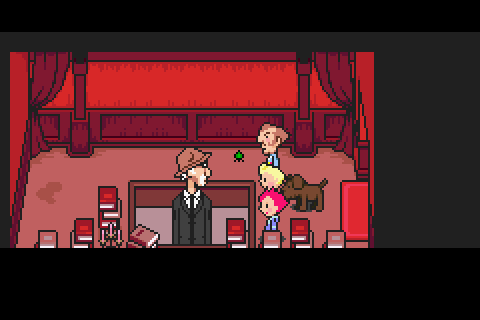I'm surprised I never saw this one mentioned. The Club Titiboo theme is actually Bill Dogget's Honkey Tonk Part 1, from 1956.
Here's the original:
Club Titiboo:
It also shows up in Animal Crossing, as K.K. Blues:
(As a side note, this is the second classic song that both Animal Crossing and Mother has used. The first was Johnny B Good which became the Hippy battle theme and K.K. Rockin')
Here's some random trivia, that may not be so random. David Lynch used the song Honkey Tonk Part 1 for his movie, Blue Velvet. Actually, that's how I first found this song. (It was already a weird movie but realizing I heard a song from Mother 3 halfway through just made it weirder.)
I may be grasping at straws, but I think Mother 3's 'Beach Combing', used appropriate for the beach area, is similar to the song titled 'Dance of Dream Man'
Lynch's films and the Mother series share the same basic concept. Basically, an idealized suburban American town, has deep dark secrets, strange occurrences, and disturbing examples human nature hidden underneath the surface. For example, Laura Palmer from the TV series Twin Peaks seemed like a normal highschool sweetheart. She was into heavy drugs, BDSM prostitution, because she was haunted by a demon. In Earthbound/Mother 2 it's a little more light hearted, but still, early on in the game you are attacked by a bunch of policemen. You have to rescue Paula from a bunch of cult members. You befriend a possible mob boss, Everest, who ends up jumping off of a building. And there's the whole Giygas thing.
Another strange, and probably coincidental, similarity is that there a strange giant character in Mother 3 and Twin Peaks. In Mother 3 we have Leder. He is mute giant, who rings the bell tower outside of Tazmily village. In Chapter 8 he is kidnapped, and the main characters discover the history of humanity before the game took place.
In Twin Peaks a giant appears to Cooper to give him many subtle clues. He's some sort of spirit that belongs another dimension, the Black and White Lodge. At one point, The Giant appears to Cooper a stage with red curtains. The Black and White lodge is full of red curtains. One of Lynch's trademarks are surreal scenes that take place in these dimensions with red drapes. For some reason, during Leder's speech in Mother 3, the room is red with red drapes on each side. The rest of the hotel where this takes place has dull, mute, neutral colours.
Giant appears to Cooper:
Leder in the red room:
The Black and White Lodge:
Red curtains are sort of common though, and the music connections aren't enough for me to be as certain as the Evangelion references in the previous post. It's worth posting at least.
Let's not forget the whole Tanetane island. I didn't notice anything visually similar. It's just Tanetane island is a total mindfuck on the level of a Lynch movie.


Hey, there. I totally appreciate what you're doing, but you do realize that in the the song you mentioned as the derivative for KK Blues and Club Titiboo is completely different than these two game tunes. While it is true that they feature strikingly similar rhythm sections, they don't feature the same lead melody whatsoever. I've been immersed with blues/jazz at college due to my major, and what you're hearing is the standard 12-Bar-Blues form of most blues/jazz standards. You see, most blues compositions don't derive from this progression of chords, and there's a whole history behind that that I won't go into... Listening to all three pieces, I could see why you would think they're the same, but in blues, the progression stays the same, while the key and melody changes. So, in reality, Club Titiboo is a much more legal-friendly, and also original, song than most of Keiichi Suzuki's work on MOTHER 2 that featured direct movements from other pieces of music.
ReplyDeleteThank you for your response and information.
ReplyDeleteThis is my first time making a blog like this, and comparing music. I know next to nothing about music and music theory.
In the future I'm just going to post and mention that they sound similar to me, because I tend to make connections that may not have ever been intended. I try to point this out as much as possible but, I honestly thought they were the same song.
Thanks!
I really, really enjoyed the comparison between Mother 3 and Lynch's work. Interesting stuff there. As someone who also enjoys this kind of thing (trivia, analysis, etc.) I'll definitely be stopping by again! This blog looks promising, keep up the good work. :)
ReplyDeleteWhoa, that last comment was me. Not sure why it came up with all those numbers and letters.
ReplyDeleteThere is also a point later in the series when Leo is enslaved by Windom Earle and is forced to wear a shock collar. Whenever Leo disobeys Earle, he is punished much like Fassad does with Salsa.
ReplyDeleteLeder can also be taken as a reference to Donne's Meditations. In addition, his name is a pun because phonetically, it could be represented as "Leider" or "Lieder". A lieder is a song setting a poem and Leder's speech is precisely that as shown with the use of Satie's Gymnopedie 1 as a backing. It is also true that it is possible that he is in fact the original leader of the people who moved to the island and the Gymnopedie is connected to antiquity, making it possible that he symbolizes the original lifestyle.
ReplyDeleteIn addition, Itoi enjoys "Twin Peaks" so that reference is likely to not be accidental.